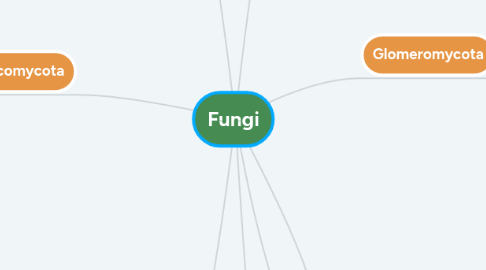
1. Basidiomycota
1.1. Mushrooms, puffballs, and shelf fungi
1.2. Basidiomycetes
1.3. Some form mycorrhizae while others are plant parasites
1.4. Defined by a clubaike structure called a basidium
1.4.1. a transient diploid stage in the life cycle
1.5. Also called club fungi
1.6. Many are decomposers of wood
1.7. Can produce mushrooms quickly
1.8. Some species may produce fairy rings
1.9. Examples
1.9.1. Mushrooms
1.9.2. Coprinus
1.10. Ectomycorrhizal fungi
2. Zygomycota
2.1. Fast growing molds, parasites, and commensal symbionts
2.2. Zygomycetes
2.3. Named for sexually produced zygosporangia
2.4. Resistant of freezing and drying
2.4.1. Can survive unfavorable conditions
2.5. Example
2.5.1. Pilobolus
2.5.1.1. Aim and shoot their sporangia toward bright light
2.5.2. Rhizopus Stolonifer
2.5.3. Mucor
2.6. Asexual Reproduction
2.6.1. Sporangiospores
2.7. Sexual Reproduction
2.7.1. Zygospores
2.8. Resistant zygosporangium of sexual stage
2.9. Decomposers, parasites, or commensal symbionts
3. Ascomycota
3.1. Ascomycetes
3.2. Live in marine, freshwater, and terrestrial habitats
3.3. Produce sexual spores in saclike asci
3.3.1. Asci are contained in fruiting bodies called ascocarps
3.4. Commonly called sac fungi
3.5. Vary in size and complexity from unicellular yeasts to elaborate cup fungi and morels
3.6. Include plant pathogens, decomposers, and symbionts
3.7. Asexual Reproduction
3.7.1. Conidia- asexual spores
3.7.1.1. Produced asexually at the tips of specialized hyphae called conidiophores
3.8. Sexual Reproduction
3.8.1. Ascospores
3.9. Example
3.9.1. Neurospora crassa
3.9.2. Peziza penicillum
3.9.3. Saccharomyces cererisiae
3.9.4. Aspergillus penicillum
3.10. Common name is orange peel fungus
4. Kayla Brockway
5. Chytridiomycota
5.1. Found in terrestrial, freshwater and marine habitats
5.2. Can be decomposers, parasites, or mutualists
5.3. Simplest fungi
5.4. Chytrids
5.5. Zoospores: Flagellated spores
5.6. Asexual Reproduction
5.6.1. motile zoospores
5.7. Sexual Reproduction
5.7.1. Sporangiospores
5.8. Example
5.8.1. Allomyces
5.9. Form multicellular, branched hyphae
5.10. Hyphae
6. Glomeromycota
6.1. Glomeromycetes
6.2. Were once considered zygomycetes
6.3. Form arbuscular mycorrhizae
6.3.1. With plant roots
6.3.2. Supplies minerals and other nutrients to roots
6.4. Symbionts of plants
6.5. Asexual reproduction
6.5.1. spores
6.5.2. fragmentation
6.6. No sexual reproduction
6.7. Example
6.7.1. Acaulospora
6.8. Glomeromycete hyphae within plant root
7. Lichen
7.1. Symbiotic association between photosynthetic microorganisms and fungus
7.2. Held in a mass of fungal hyphae
7.3. Asexual Reproduction
7.3.1. fragmentation
7.3.2. Formation of soredia
7.3.2.1. small clusters of hyphae with embedded algae
7.4. Example
7.4.1. Placopsis perrugosa
7.4.2. Crustose
7.4.3. Fruticose
7.4.4. Foliose
7.5. Used to predict pollution due to their intolerance
8. Key Traits of All Fungi
8.1. Absoriptive heterotrophy
8.1.1. Enzymes are used to break down a large variety of complex molecules into smaller organic compounds
8.2. Evolutionary advantage
8.3. Diverse lifestyle
8.3.1. decomposers
8.3.2. Parasites
8.3.3. Mutualists
8.4. Body Structure
8.4.1. Multicellular filaments and single cells called yeasts
8.4.1.1. Some grow as either filaments or yeasts while some do both
8.4.2. Hyphae: network of tiny filaments
8.4.2.1. Septa divide hyphae
8.4.3. Chitin: what cell walls are composed of
8.4.4. Mycelia: netoworks of branched hyphae for absorption
8.4.5. Coenocytic fungi
8.4.5.1. lack septa
